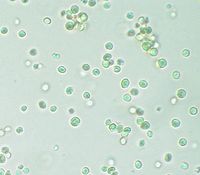
Photo from wikipedia
Chlorella kessleri accumulates triacylglycerol usable for biodiesel-fuel production to >20% dry cell weight in three days when cultured in three-fold diluted seawater, which imposes the combinatory stress of hyperosmosis and… Click to show full abstract
Chlorella kessleri accumulates triacylglycerol usable for biodiesel-fuel production to >20% dry cell weight in three days when cultured in three-fold diluted seawater, which imposes the combinatory stress of hyperosmosis and nutrients limitation. The quantitative behavior of major C-compounds, and related-gene expression patterns were investigated in Chlorella cells stressed with hyperosmosis, nutrients limitation, or their combination, to elucidate the C-metabolism for economical seawater-based triacylglycerol accumulation. Combinatory-stress cells showed repressed protein synthesis with initially accumulated starch being degraded later, the C-metabolic flow thereby being diverted to fatty acid and subsequent triacylglycerol accumulation. This C-flow diversion was induced by cooperative actions of nutrients-limitation and hyperosmosis. Semi-quantitative PCR analysis implied positive rewiring of the diverted C-flow into triacylglycerol in combinatory-stress cells through upregulation of gene expression concerning fatty acid and triacylglycerol synthesis, and starch synthesis and degradation. The information of regulatory C-metabolism will help reinforce the seawater-based triacylglycerol accumulation ability in algae including Chlorella.
Journal Title: Bioresource technology
Year Published: 2019
Link to full text (if available)
Share on Social Media: Sign Up to like & get
recommendations!